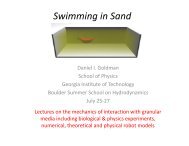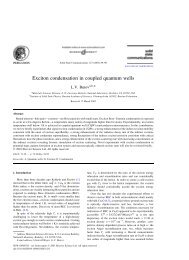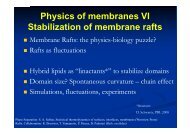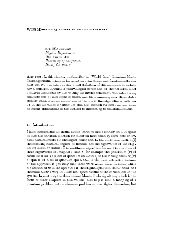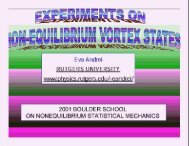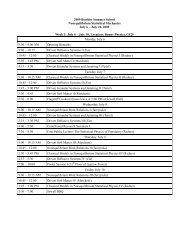Polariton lasing vs. photon lasing in a semiconductor microcavity
Polariton lasing vs. photon lasing in a semiconductor microcavity
Polariton lasing vs. photon lasing in a semiconductor microcavity
Create successful ePaper yourself
Turn your PDF publications into a flip-book with our unique Google optimized e-Paper software.
<strong>Polariton</strong> <strong>las<strong>in</strong>g</strong> <strong>vs</strong>. <strong>photon</strong> <strong>las<strong>in</strong>g</strong> <strong>in</strong> a<strong>semiconductor</strong> <strong>microcavity</strong>Hui Deng* † , Gregor Weihs* ‡ , David Snoke § , Jacquel<strong>in</strong>e Bloch , and Yoshihisa Yamamoto* , ***Quantum Entanglement Project, International Cooperative Research Project (ICORP), Japan Science and Technology Corporation, Edward L. G<strong>in</strong>ztonLaboratory, Stanford University, Stanford, CA 94305; ‡ Institute of Industrial Science, Tokyo University, 4-6-1 Komaba, Meguro-ku, Tokyo 153-8904, Japan;§ Department of Physics and Astronomy, University of Pittsburgh, 3841 O’Hara Street, Pittsburgh, PA 15260; Laboratory of Photonic and Nanostructures,Centre National de la Recherché Scientifique, Route de Nozay, 91460 Marcoussis, France; and **NTT Basic Research Laboratories, Mor<strong>in</strong>osato Wakamiya,Astugishi, 243-0198 Kanagawa, JapanEdited by Paul C. Mart<strong>in</strong>, Harvard University, Cambridge, MA, and approved October 29, 2003 (received for review July 10, 2003)Nearly one decade after the first observation of Bose–E<strong>in</strong>ste<strong>in</strong> condensation<strong>in</strong> atom vapors and realization of matter-wave (atom)lasers, similar concepts have been demonstrated recently for polaritons:half-matter, half-light quasiparticles <strong>in</strong> <strong>semiconductor</strong> microcavities.The half-light nature of polaritons makes polariton laserspromis<strong>in</strong>g as a new source of coherent and nonclassical light withextremely low threshold energy. The half-matter nature makes polaritonlasers a unique test bed for many-body theories and cavityquantum electrodynamics. In this article, we present a series ofexperimental studies of a polariton laser, explor<strong>in</strong>g its properties asa relatively dense degenerate Bose gas and compar<strong>in</strong>g it to a <strong>photon</strong>laser achieved <strong>in</strong> the same structure. The polaritons have an effectivemass that is twice the cavity <strong>photon</strong> effective mass, yet seven ordersof magnitude less than the hydrogen atom mass; hence, they canpotentially condense at temperatures seven orders of magnitudehigher than those required for atom Bose–E<strong>in</strong>ste<strong>in</strong> condensations.Accompany<strong>in</strong>g the phase transition, a polariton laser emits coherentlight but at a threshold carrier density two orders of magnitude lowerthan that needed for a normal <strong>photon</strong> laser <strong>in</strong> a same structure. It alsois shown that, beyond threshold, the polariton population splits to athermal equilibrium Bose–E<strong>in</strong>ste<strong>in</strong> distribution at <strong>in</strong>-plane wave numberk > 0 and a nonequilibrium condensate at k 0, with a chemicalpotential approach<strong>in</strong>g to zero. The spatial distributions and polarizationcharacteristics of polaritons also are discussed as unique signaturesof a polariton laser.Experimentally realized macroscopic degenerate boson systems,such as lasers, superfluid He 3 and He 4 , the Bardeen–Cooper–Schreiffer state <strong>in</strong> superconductors, and Bose–E<strong>in</strong>ste<strong>in</strong> condensation(BEC) of atomic vapors, have deepened our fundamentalunderstand<strong>in</strong>g of macroscopic quantum orders and led to novelresearch tools as well as applications. A miss<strong>in</strong>g member from thefamily has been a macroscopically ordered state of weakly <strong>in</strong>teract<strong>in</strong>gbosons <strong>in</strong> condensed matter systems. Exciton and polaritonBECs are the most promis<strong>in</strong>g candidates <strong>in</strong> this category. S<strong>in</strong>ce theywere first proposed <strong>in</strong> the 1960s (1–3), tremendous efforts havebeen engaged <strong>in</strong> the search (4–13). Exciton and polariton BECs areattractive yet elusive because of the complications <strong>in</strong>herent tosolid-state systems with strong Coulomb <strong>in</strong>teractions. It is a formidabletask to describe the excitations <strong>in</strong> solids <strong>in</strong> full detail. Thecommon approach is to treat the stable ground state of an isolatedsystem as a quasivacuum and to <strong>in</strong>troduce quasiparticles as units ofelementary excitation, which only weakly <strong>in</strong>teract with each other.An exciton is a typical example of such a quasiparticle. As a resultof optical excitation from the crystal ground state, an excitonconsists of a bound pair of an electron and hole whose Coulomb<strong>in</strong>teraction serves as the b<strong>in</strong>d<strong>in</strong>g energy. Excitons have <strong>in</strong>tegral totalsp<strong>in</strong>, thus they behave like bosons, weakly <strong>in</strong>teract<strong>in</strong>g with eachother through the residual Coulomb <strong>in</strong>teractions of the fermionicconstituents. The envelope wave function of an exciton is analogousto that of a hydrogen atom, <strong>in</strong> which an electron is bound to anucleus. However, because of the strong dielectric screen<strong>in</strong>g <strong>in</strong>solids and a small effective mass ratio of the hole to the electron,the b<strong>in</strong>d<strong>in</strong>g energy of an exciton <strong>in</strong> gallium arsenide (GaAs) is onthe order of 10 meV (1 eV 1.602 10 19 J), three orders ofmagnitude smaller than that of hydrogen atoms, and the radius ofan exciton is 10 2 Å, extend<strong>in</strong>g over tens of atomic sites <strong>in</strong> thecrystal. With the well developed techniques of molecular beamepitaxy, very high quality quantum conf<strong>in</strong>ement structures can beeng<strong>in</strong>eered. In a quantum well (QW) structure, excitons are conf<strong>in</strong>ed<strong>in</strong>side a <strong>semiconductor</strong> layer with thickness comparable to theexciton radius, which restricts them to two-dimensional motion atlow temperature. In GaAs, the lowest QW exciton states are splitby sp<strong>in</strong>-orbit <strong>in</strong>teraction <strong>in</strong>to two sp<strong>in</strong> doublets, one J 1 doubletthat <strong>in</strong>teracts strongly with the light field and one J 2 doublet forwhich light emission and absorption are forbidden. When the GaAsQWs are placed at the ant<strong>in</strong>odes of a <strong>semiconductor</strong> <strong>microcavity</strong>,the J 1 exciton doublet strongly <strong>in</strong>teracts with the optical field ofthe cavity, and new quasiparticles are formed called the upperpolariton (UP) and lower polariton (LP) (14). The splitt<strong>in</strong>g betweenthe UP and LP energies is determ<strong>in</strong>ed by the number of QWs (15)and the coupl<strong>in</strong>g strength of the <strong>in</strong>terband dipole moment to thecavity optical mode.Dynamic Condensation of <strong>Polariton</strong>sAs a l<strong>in</strong>ear superposition state of a cavity <strong>photon</strong> and a QWexciton, a polariton also obeys boson statistics at low densities.Hence, a BEC-type transition is expected when the correlationlength of the LPs is comparable to or larger than the size of thesystem, which is determ<strong>in</strong>ed by the spot size of the pump laser<strong>in</strong> real experiments (16). A conventional BEC exists <strong>in</strong> a thermalequilibrium system, where the particle lifetime is much longerthan the relaxation time. However, the polariton condensationdiscussed here is dynamic <strong>in</strong> nature. The lifetime of the polaritonsis shorter than or comparable to their energy relaxation timebecause of the leakage of their <strong>photon</strong>ic components from thecavity. Hence, the polariton condensate is not <strong>in</strong> thermal equilibriumwith its host lattice, and the phase transition is accompaniedby emission of coherent light, which is analogous to anatom laser created out of an atom BEC. For this reason, we callthe dynamic condensation of polaritons a ‘‘polariton laser.’’In comparison with atom BECs, the dynamic condensation of<strong>microcavity</strong> polaritons occurs at a strik<strong>in</strong>gly high temperature as aresult of the mix<strong>in</strong>g with cavity <strong>photon</strong>s. Because of the dispersionof a cavity mode, cavity <strong>photon</strong>s have an effective mass, but it is fourorders of magnitude lighter than the exciton effective mass. A cavitymode and an exciton strongly couple to form polariton modes onlywhen they have similar energies at the same <strong>in</strong>-plane wave vectork . In the case that the <strong>photon</strong> mode is resonant with the excitonmode at k 0, a polariton <strong>in</strong> the k 0 state is half <strong>photon</strong> andThis paper was submitted directly (Track II) to the PNAS office.Abbreviations: BE, Bose–E<strong>in</strong>ste<strong>in</strong>; BEC, BE condensation; GaAs, gallium arsenide; QW,quantum well; LP, lower polariton; UP, upper polariton.† To whom correspondence should be addressed at: Stanford University, 316 Via PauloStreet, Stanford, CA 94305. E-mail: dhui@stanford.edu.© 2003 by The National Academy of Sciences of the USA15318–15323 PNAS December 23, 2003 vol. 100 no. 26 www.pnas.orgcgidoi10.1073pnas.2634328100
half exciton, with an effective mass m pol twice the <strong>photon</strong> mass, fourorders of magnitude lighter than the exciton mass, and seven ordersof magnitude lighter than the hydrogen atom mass. At the sametime, the typical <strong>in</strong>terparticle spac<strong>in</strong>g, <strong>in</strong> units of the particle Bohrradius a B ,is1(n 1 2Da 2 B ) 10 <strong>in</strong> polariton systems, much less than1(n 1 3Da 3 B ) 10 3 <strong>in</strong> atom vapors. In other words, the density ofpolaritons <strong>in</strong> unitless numbers is generally much higher than that ofatoms. Consequently, the critical temperature for polariton condensationsis generally eight orders of magnitude higher than thatneeded for atom BECs. Room temperature dynamic condensationof polaritons <strong>in</strong> wide band gap <strong>semiconductor</strong>s is not out of reachwith present day techniques (15, 17).The high density of polaritons also implies that <strong>in</strong>teractionsamong them are more important than <strong>in</strong> atomic gases. This meansthat a polariton laser also offers a unique test bed for many-bodyphysics theories. For example, when the quasiparticle density<strong>in</strong>creases, a smooth transition from a polariton laser to a Bardeen–Cooper–Schreiffer-like state of excitons has been predicted for asystem with low exciton decoherence rate (18, 19).Another pronounced advantage of a polariton laser lies <strong>in</strong> theone-to-one correspondence between the polaritons and the <strong>photon</strong>semitted from the cavity. The <strong>photon</strong> component of a polaritonhas a fixed decay rate (normally on the order of 0.1 THz) out of thecavity. The emission of a <strong>photon</strong> preserves the polariton energy and<strong>in</strong>-plane wave vector. Therefore, the detected <strong>photon</strong>s carry direct<strong>in</strong>formation of the polaritons. The <strong>in</strong>tensity of the emission isproportional to the <strong>in</strong>stantaneous polariton population, and thequantum statistical properties of the emission replicate those of thepolaritons. Conversely, polaritons <strong>in</strong> certa<strong>in</strong> momentum states canbe selectively excited through resonant optical pump<strong>in</strong>g.Experimental Pr<strong>in</strong>ciplesBecause of the <strong>in</strong>herent complications of solid-state systems, observ<strong>in</strong>gthe effect of polariton <strong>las<strong>in</strong>g</strong> requires careful attention toother nonl<strong>in</strong>ear effects <strong>in</strong> the system. One example is coherentoptical parametric amplification <strong>in</strong> a <strong>microcavity</strong> enhanced bypolariton resonances (20–22). It is also based on the LP-LPscatter<strong>in</strong>g that orig<strong>in</strong>ates from Columbic <strong>in</strong>teraction between fermionicconstituents, and there is also a nonl<strong>in</strong>ear <strong>in</strong>crease ofcoherent <strong>photon</strong> flux <strong>in</strong>to the normal direction at k 0 LP energy.The ga<strong>in</strong> <strong>in</strong> this case, however, is provided by coherent opticalnonl<strong>in</strong>earities when both the pump and probe lasers are tuned toresonantly excite the k 0 polariton mode. The coherence of thek 0 state is directly <strong>in</strong>herited from the pump laser, analogous tothe process of coherent four-wave mix<strong>in</strong>g <strong>in</strong> nonl<strong>in</strong>ear optics. In thepresent experiments, however, the pump laser excites polaritonstates at large k , so that the coherence of the pump laser is lost bymultiple phonon emission before the polaritons arrive at the k 0 states. The polaritons can only acquire macroscopic coherence byspontaneous symmetry break<strong>in</strong>g at the phase transition threshold.The coherence then is carried <strong>in</strong>to the light field when the <strong>photon</strong>component of the polaritons leads to <strong>photon</strong> emission.If the carrier density <strong>in</strong>creases above a saturation density, thequasiparticle picture of polaritons breaks down, when <strong>in</strong>ducedtransparency due to phase space fill<strong>in</strong>g reduces the exciton<strong>photon</strong>coupl<strong>in</strong>g strength to the po<strong>in</strong>t that the LP-UP splitt<strong>in</strong>gis less than the l<strong>in</strong>e width. In this situation, the normal modes ofthe system become the cavity <strong>photon</strong> and the QW exciton.Further <strong>in</strong>crease of the carrier density to above the electronic<strong>in</strong>version condition leads to dissociation of the excitons <strong>in</strong>toelectron-hole plasma, and standard <strong>photon</strong> <strong>las<strong>in</strong>g</strong> takes place ifthe ga<strong>in</strong> for the cavity <strong>photon</strong> mode exceeds its loss.To realize polariton <strong>las<strong>in</strong>g</strong> before exciton saturation andtransition to <strong>photon</strong> <strong>las<strong>in</strong>g</strong> requires appropriate eng<strong>in</strong>eer<strong>in</strong>g ofthe <strong>microcavity</strong> sample and efficient cool<strong>in</strong>g of the hot-<strong>in</strong>jectedexcitons. The molecular-beam-epitaxy-grown sample we usedconta<strong>in</strong>s a 2 GaAs cavity sandwiched between Ga 0.8 Al 0.2 AlAs distributed Bragg reflectors. Three stacks of QW areplaced at the central three ant<strong>in</strong>odes of a <strong>microcavity</strong>, each stackconsist<strong>in</strong>g of four 7-nm-thick GaAs QWs separated by-3 nmthickAlAs layers. The <strong>microcavity</strong> thickness is tapered to allowtun<strong>in</strong>g of the cavity resonance by chang<strong>in</strong>g the spot where thelaser excites the sample. With a total of 12 QWs, the effectiveexciton density per QW is reduced to 112 of the total excitondensity, suppress<strong>in</strong>g the exciton density by an order of magnitudefor a given polariton population. Moreover, the UP-LP splitt<strong>in</strong>gis <strong>in</strong>creased by approximately the square root of the number ofQWs (15, 23). Reflectivity measurements at 4 K showed am<strong>in</strong>imum UP-LP splitt<strong>in</strong>g of 14.9 meV. Because the splitt<strong>in</strong>g iscomparable to the bare exciton b<strong>in</strong>d<strong>in</strong>g energy of 10 meV, theeffective size of the exciton component <strong>in</strong> the LP was predictedto be reduced dramatically (24). All these effects contribute toovercom<strong>in</strong>g the saturation of excitons at high density.In our experiments, the cavity mode was chosen to be resonantwith the QW excitons at k 0, where their dipole coupl<strong>in</strong>g ismaximum. The LPs have a dispersion relation:E LP k 1 2 E exc E c E exc E c 2 4, [1]where E exc and E c are the k -dependent energies of the bare QWexcitons and the cavity <strong>photon</strong> modes, and is the collective dipolecoupl<strong>in</strong>g strength, which <strong>in</strong> this case equals the splitt<strong>in</strong>g of k 0LP and UP. Resonant optical pump<strong>in</strong>g by mode-locked laser pulsesis adopted to create <strong>in</strong>stantaneously a population of exciton-likeLPs at a large k , so as to m<strong>in</strong>imize the excitation of free electronsand holes, which usually <strong>in</strong>crease the exciton decoherence rate.There are also <strong>in</strong>dications recently that a large population of freeelectrons, however, may assist the energy relaxation of excitons(25–28). Dark J 2 excitons, which are created by sp<strong>in</strong> flip fromthe light-generated J 1 excitons with a time constant of 100 ps(29), also may play a role. Injected exciton-like LPs relax by LP-LPscatter<strong>in</strong>g and phonon emission, thereby los<strong>in</strong>g the coherence<strong>in</strong>herited from the pump wave and form<strong>in</strong>g a real LP populationwith a quasithermal distribution. Phonon emission is sufficient tocool LPs at k 0.1 k 0 , where k 0 is the total wave number of thecavity <strong>photon</strong> at k 0. However, the process becomes very<strong>in</strong>efficient <strong>in</strong> the region k 0.1 k 0 , where the coupl<strong>in</strong>g between thecavity <strong>photon</strong> and the QW exciton becomes strong. In this region,as k decreases toward k 0, the effective LP mass is reduced fromnearly the exciton mass to twice the <strong>photon</strong> mass, lead<strong>in</strong>g to a rapiddecrease of the density of states of the LPs by four orders ofmagnitude. Furthermore, the lifetime of the LPs decreases fromnearly the exciton lifetime of 500 ps to 4 ps. Consequently, mostof the <strong>in</strong>jected excitons decay radiatively before they relax to thebottom of the LP branch if only phonon emission is responsible forthe cool<strong>in</strong>g. The crucial process that efficiently cools LPs is theelastic scatter<strong>in</strong>g of two LPs <strong>in</strong>to one near k 0 and one at higherenergy. This process is enhanced by the bosonic f<strong>in</strong>al-state stimulationwhen the LP population per mode <strong>in</strong> the k 0 states exceedsunity (30). This stimulated LP-LP scatter<strong>in</strong>g is a phase-coherentprocess analogous to the stimulated emission of <strong>photon</strong>s <strong>in</strong> a laser.Consequently, a macroscopic coherent population quickly can buildup <strong>in</strong> the k 0 LP state, form<strong>in</strong>g a polariton laser.In all of our experiments, the sample temperature was 4 K. Amode-locked Ti-Sapphire laser (Coherent, Santa Clara, CA) witha pulse duration of 3 ps and a repetition rate of 76 MHz was usedas the pump laser. The emitted light was collected with an angularresolution of 0.5° <strong>in</strong> air by us<strong>in</strong>g an optical fiber that was <strong>in</strong> turnconnected to a charge-coupled device camera and imag<strong>in</strong>g spectrometeror a streak camera for time-doma<strong>in</strong> analysis. To measurethe real-space polariton distribution, the LP emission was imagedonto a charge-coupled device camera by an aspheric microscopelens with a numerical aperture of 0.7. The lens was placed near thesample and aligned to the sample normal. In all measurements, thepump was either l<strong>in</strong>early or circularly polarized and focused to aPHYSICSDeng et al. PNAS December 23, 2003 vol. 100 no. 26 15319
Fig. 1. Number of LPs and cavity <strong>photon</strong>s per mode <strong>vs</strong>. <strong>in</strong>jected carrierdensity for a polariton laser <strong>in</strong> scheme I (triangles) and a <strong>photon</strong> laser <strong>in</strong>scheme II (circles), respectively. The gray zone marks the population <strong>in</strong>versiondensities from band edge to 15 meV above the band edge.spot 15 m <strong>in</strong> diameter at a position on the sample where the QWexciton was resonant with the cavity <strong>photon</strong> under weak excitation.At 45° from normal <strong>in</strong>cidence <strong>in</strong> air, the pump was resonant withLPs hav<strong>in</strong>g an <strong>in</strong>-plane wave number k 5.33 10 4 cm 1 .Atthis<strong>in</strong>cidence angle, direct coherent optical four-wave mix<strong>in</strong>g is forbidden.We call this experimental condition scheme I. A scheme IIwas adopted to measure the phase transition of a <strong>photon</strong> laser <strong>in</strong> thesame sample by us<strong>in</strong>g the same experiment setup. In scheme II, thepump laser was focused to a different position on the sample, wherethe cavity mode is blue-detuned to 15 meV above the band edge.The pump energy was tuned accord<strong>in</strong>gly to be resonant with thecavity mode energy at k 5.33 10 4 cm 1 .Threshold Carrier DensitiesPhase transitions are observed <strong>in</strong> both schemes, as <strong>in</strong>dicated bythe sharp superl<strong>in</strong>ear <strong>in</strong>crease of the emission <strong>in</strong>tensity <strong>in</strong>to thenormal direction with <strong>in</strong>creas<strong>in</strong>g pump <strong>in</strong>tensity (Fig. 1). However,the critical carrier densities †† are different by two orders ofmagnitude. In the polariton laser case (scheme I), the pumppower density at threshold is P th 300 Wcm 2 , correspond<strong>in</strong>gto an <strong>in</strong>jected exciton density of n QW 3 10 9 cm 2 per pulseper QW. ‡‡ It is about two orders of magnitude smaller than theMott transition density (n 1a B 2 ) and transparency conditionof 10 11 cm 2 electron-hole pairs per QW. The LP population permode around k 0 at threshold is estimated to be of the orderof unity. §§ This f<strong>in</strong>d<strong>in</strong>g <strong>in</strong>dicates that the nonl<strong>in</strong>ear <strong>in</strong>crease <strong>in</strong>the <strong>in</strong>put–output relation <strong>in</strong> Fig. 1 orig<strong>in</strong>ates from the onset ofthe stimulated scatter<strong>in</strong>g of LPs <strong>in</strong>to the k 0 state.†† Here the critical density is def<strong>in</strong>ed where the nonl<strong>in</strong>earity is the largest <strong>in</strong> the <strong>in</strong>put–output relation.‡‡ n QW (n QW) for polariton condensation (for <strong>photon</strong> <strong>las<strong>in</strong>g</strong>) is estimated from the numberof pump <strong>photon</strong>s per pulse 5 10 7 (6 10 8 ) multiplied by the net absorption of the<strong>microcavity</strong> system of 0.12% (2.3%) calculated by the transfer matrix method anddivided by the number of QWs N 12. For a spot of D 15 m <strong>in</strong> diameter, n QW 3 10 9 cm 2 per pulse (n QW 3 10 11 cm 2 ).§§ LP population n k 0 at threshold is estimated to be 1byN LP n LPMf pT p LP with thefollow<strong>in</strong>g parameters: the detected <strong>photon</strong> flux N LP 2,500 s 1 ; the repetition rate ofthe mode-locked pump laser f p 76 MHz; the overall detection efficiency 10 4 ; theemitted pulse duration T p 10 ps; LP lifetime 4 ps; andM 1 D 2 42 4 2 (k 0 ) 2 4is the number of transverse states subtended by the acceptance angle of the detector 0.01. k 0 8.15 10 4 cm 1 is the free space logitud<strong>in</strong>al wave number of the cavity <strong>photon</strong>.Cavity <strong>photon</strong> number per mode <strong>in</strong> k 0 is estimated <strong>in</strong> the same way, except that thecavity <strong>photon</strong> lifetime is 2 ps.Fig. 2. Comparison of the measured and calculated dispersion curves. (a–c)Measured LP dispersion curves (circles) and calculated cavity <strong>photon</strong> (dotted l<strong>in</strong>e),unshifted LP (dashed-dotted l<strong>in</strong>e), and blue-shifted LP (dashed l<strong>in</strong>e) dispersioncurves <strong>in</strong> scheme I, P th 300 Wcm 2 . Orig<strong>in</strong> of the cavity <strong>photon</strong> dispersion isartificially shifted for comparison. (d) Measured (diamonds) and calculated (dottedl<strong>in</strong>e) cavity <strong>photon</strong> dispersion curves <strong>in</strong> scheme II, P th 2KWcm 2 .In the <strong>photon</strong> laser case, the <strong>in</strong>jected carrier density at thresholdis approximately n QW 3 10 11 cm 2 per pulse per QW, ‡‡ whichis approximately the density required for electronic population<strong>in</strong>version at 15 meV above the band edge. This result is <strong>in</strong>agreement with the standard laser mechanism. That is, the thresholdof a <strong>semiconductor</strong> laser is solely determ<strong>in</strong>ed by the electronic<strong>in</strong>version condition if the active volume of the laser is largecompared to its optical mode volume (31). The cavity <strong>photon</strong>number per mode is estimated to be of the order of unity aga<strong>in</strong> atthreshold. §§ This <strong>in</strong>dicates that the nonl<strong>in</strong>ear <strong>in</strong>crease <strong>in</strong> the <strong>in</strong>put–output relation orig<strong>in</strong>ates from the onset of the stimulated emissionof <strong>photon</strong>s <strong>in</strong>to the k 0 cavity <strong>photon</strong> mode.Dispersion CharacteristicsTo identify the normal modes of the above two nonl<strong>in</strong>ear systems,we studied the energy <strong>vs</strong>. the transverse wave number by measur<strong>in</strong>gthe energy of the far-field emission at various external emissionangles with an angular resolution of 0.5°. The dispersion curvemeasured for the polariton laser <strong>in</strong> scheme I agrees very well withthe LP dispersion curve calculated with the transfer matrix method(Fig. 2 a–c). Below the polariton laser threshold, the energy of theLP photolum<strong>in</strong>escence is shifted slightly below the calculateddispersion curve (Fig. 2a) because of the Stokes shift of QWexcitons. The shift is more noticeable at larger emission angleswhere the LP l<strong>in</strong>e width is wider because of an <strong>in</strong>creas<strong>in</strong>g portionof the exciton component and larger TE-TM splitt<strong>in</strong>g of the cavitymodes (32). The blue shift of the whole dispersion curve with<strong>in</strong>creas<strong>in</strong>g pump rate reflects the exciton-polariton nonl<strong>in</strong>earitiesstemm<strong>in</strong>g from the Coulomb <strong>in</strong>teraction and Pauli exclusion pr<strong>in</strong>cipleof the component fermions. As seen <strong>in</strong> Fig. 2 b, blue-shiftedand nonshifted dispersions coexist. As discussed below, the spatialdistribution of the polaritons changes abruptly at the threshold,lead<strong>in</strong>g to a high concentration of polaritons <strong>in</strong> the center of thelaser spot, surrounded by a broad distribution of polaritons at lowerdensity. We <strong>in</strong>terpret the coexistence of the two dispersion curvesas attributable to this spatial <strong>in</strong>homogeneity. The blue-shifteddispersion corresponds to the central region and the nonshifteddispersion corresponds to the peripheral, non<strong>las<strong>in</strong>g</strong> region. Wellabove the threshold, the nonshifted dispersion is no longer seen,because the <strong>in</strong>tensity of the blue-shifted LP emission dom<strong>in</strong>ates thelight emission (Fig. 2c). The measured dispersion follows unam-15320 www.pnas.orgcgidoi10.1073pnas.2634328100 Deng et al.
Fig. 3. Momentum space distribution of LPs. (a) The measured LP populationper state <strong>vs</strong>. k (stars), compared with BE (solid l<strong>in</strong>e) and Maxwell–Boltzmann(dotted l<strong>in</strong>e) distribution functions at pump rates PP th 1.5 and PP th 0.6(Inset). At PP th 0.6, the fitted BE and Maxwell–Boltzmann distributioncurves almost overlap. (b) The dimensionless chemical potential <strong>vs</strong>. pumprate PP th and the fitted effective LP temperature T LP <strong>vs</strong>. pump rate (Inset). Thedashed l<strong>in</strong>es are a guide for the eye.biguously the calculated LP dispersion, which takes <strong>in</strong>to account theblue shift of the excitons.In scheme II (Fig. 2d), the measured dispersion curve agreesvery well with the bare cavity mode dispersion except for a redshift of the <strong>las<strong>in</strong>g</strong> modes at k 0 attributable to the modepull<strong>in</strong>geffect <strong>in</strong> <strong>semiconductor</strong> lasers (33). The emission energiesare determ<strong>in</strong>ed ma<strong>in</strong>ly by the cavity resonance, whereas theelectronic population <strong>in</strong>version with a maximum ga<strong>in</strong> at a lowerenergy pulls the <strong>las<strong>in</strong>g</strong> energy slightly toward the ga<strong>in</strong> maximum.The difference <strong>in</strong> the dispersion characteristics shown <strong>in</strong> Fig.2 c and d provides further evidence that the two nonl<strong>in</strong>earthreshold behaviors seen <strong>in</strong> Fig. 1 correspond to the polariton<strong>las<strong>in</strong>g</strong> and <strong>photon</strong> <strong>las<strong>in</strong>g</strong>, respectively.Momentum Space DistributionAs reported <strong>in</strong> ref. 13, above the phase transition threshold <strong>in</strong>scheme I, a decrease of the second-order coherence function ofthe k 0 emission was observed, <strong>in</strong>dicat<strong>in</strong>g the formation ofmacroscopic coherence <strong>in</strong> the LP condensate.Another important aspect dist<strong>in</strong>guish<strong>in</strong>g the quantum state ofpolariton laser from a classical state is the momentum-spacedistribution of LPs. We converted the time-<strong>in</strong>tegrated <strong>in</strong>tensity ofthe angle-resolved LP emission to the number density of LPs bytak<strong>in</strong>g <strong>in</strong>to account the density of states and the radiative lifetimeof LPs. In Fig. 3a, the LP number density <strong>vs</strong>. <strong>in</strong>-plane wave numberk is compared with the classical Maxwell–Boltzmann distribution,NE exp E LPk E LP 0,k B T LPand the quantum mechanical Bose–E<strong>in</strong>ste<strong>in</strong> (BE) distribution,NE 1exp E LPk E LP 0 k B T LP 1,where the effective polariton temperature T LP and chemicalpotential are fitt<strong>in</strong>g parameters, and k B is the Boltzmannconstant. The dimensionless chemical potential is def<strong>in</strong>ed (E LP (0) )k B T LP . A lowest k k 0.2 10 4 cm 1 is used,correspond<strong>in</strong>g to quantization <strong>in</strong> an area 15 m <strong>in</strong> diameter,which is determ<strong>in</strong>ed by the pump spot size. k also correspondsto an experimental angular resolution of 0.3°.Below threshold, neither distribution fits the data well, probablybecause most of the polaritons decay radiatively before the systemcan reach thermal equilibrium (Fig. 3a Inset). Close to threshold,the BE distribution fits the data, with a fitted T LP 50 K andE LP (0) 4.4 meV, result<strong>in</strong>g <strong>in</strong> 1. This marks thetransition to a quantum degenerate gas. Also there is an extra peakabove the thermal BE distribution appear<strong>in</strong>g at k 0. This resultimplies that LPs start to accumulate <strong>in</strong> states with small k , andhence the dynamic condensation of LPs is accelerated. Abovethreshold, surpris<strong>in</strong>gly good agreement with a BE distribution isobta<strong>in</strong>ed, except for the extra population <strong>in</strong> the condensed k 0state (Fig. 3a). decrease rapidly near the threshold and reaches am<strong>in</strong>imum of 0.02 at PP th 1.7 (Fig. 3b). This f<strong>in</strong>d<strong>in</strong>gdemonstrates that the LPs form a degenerate Bose gas.The fitted LP effective temperature T LP is higher than thelattice temperature of 4 K, and it <strong>in</strong>creases with <strong>in</strong>creas<strong>in</strong>g pumprate (Fig. 3b Inset). This is because with <strong>in</strong>creas<strong>in</strong>g pump rate,energy relaxation of LPs is dom<strong>in</strong>ated by the efficient LP-LPscatter<strong>in</strong>g rather than the <strong>in</strong>efficient LP-phonon scatter<strong>in</strong>g, andtherefore a quasiequilibrium is established among LPs before anequilibrium with the phonon reservoir can be established. Thehigh effective temperature of the LPs implies that the polaritonlaser may survive at lattice temperatures higher than 4 K. Far above threshold, the LP-LP <strong>in</strong>teraction becomes strong.Therefore the condensate beg<strong>in</strong>s to be depleted, and the phasespace fill<strong>in</strong>g of the excitons also becomes more severe. A BEdistribution of free bosons is no longer appropriate to describethe experimental data; a theory for strongly <strong>in</strong>teract<strong>in</strong>g particlesis needed <strong>in</strong> this regime.Relaxation Time <strong>vs</strong>. <strong>Polariton</strong> LifetimeIn accord with the observed quasithermal equilibrium of LPsnear and above threshold, acceleration of the LP relaxation wasseen <strong>in</strong> a time-doma<strong>in</strong> spectral measurement. As shown <strong>in</strong> Fig.4, when the pump rate <strong>in</strong>creases beyond the threshold, theturn-on time of the emission at k 0 quickly drops to becomecomparable to the lifetime of the k 0 and k 0.1 k 0 LPs,which are 4 ps and 8 ps, respectively.Real Space DistributionComplementary to the momentum space distribution, we havemeasured the real space distribution of the LPs (Fig. 5). Atwo-dimensional Gaussian profile of the LP population is observedbelow threshold with a full width at half maximum spotsize 15 m. Because of the steep <strong>in</strong>cidence angle of thepump laser, the spot is slightly elliptical, i.e., wider along thepump <strong>in</strong>cidence direction (x) and narrower along the orthogonaldirection (y) (Figs. 5a and 6a). Close to threshold, a sharp peakemerges at the center of the spot, reduc<strong>in</strong>g the spot size to am<strong>in</strong>imum of D m<strong>in</strong> 3 m atPP th 1 (Fig. 5b). Correspond<strong>in</strong>gto such a small region, the far-field emission of the lowest-energymode spreads over a region ⎪k ⎪ /D m<strong>in</strong> 1 10 4 cm 1 . Thisexpla<strong>in</strong>s the flatten<strong>in</strong>g of the dispersion curve near k 0at Note that when 1, the fitt<strong>in</strong>g of T LP bears a much larger error compared to , becausethe total population is also a fitt<strong>in</strong>g parameter and the shape of the curve becomes rather<strong>in</strong>sensitive to the temperature.PHYSICSDeng et al. PNAS December 23, 2003 vol. 100 no. 26 15321
Fig. 4. Turn-on time on of the emission at k 0 <strong>vs</strong>. pump rate PP th(triangles) compared to the LP lifetimes at k 0 and k 0.1 k 0 (dashed-dottedl<strong>in</strong>es), where on is def<strong>in</strong>ed as the delay of the maximum of the emissionrelative to the pump. It is derived from the time-doma<strong>in</strong> spectral measurementafter deconvolution of pump spectrum from the emission spectra. Thedashed l<strong>in</strong>e is a guide for the eye.PP th 1, as observed <strong>in</strong> Fig. 2b. Because the emission from thewhole area was collected <strong>in</strong> the measurements, the centralcondensed LPs and the peripheral noncondensed LPs expla<strong>in</strong>the coexistence of two dispersion curves <strong>in</strong> Fig. 2b.The spatial profile measured for a <strong>photon</strong> laser <strong>in</strong> scheme II alsois reduced <strong>in</strong> size at the <strong>las<strong>in</strong>g</strong> threshold, with a m<strong>in</strong>imum diameterof 7 m. Because the spatial distribution of the electron-hole pairsdeterm<strong>in</strong>es the local ga<strong>in</strong>, the region where the electron-holedensity reaches the threshold value grows accord<strong>in</strong>g to 0 1 log 2 1 P th P , [2]where 0 is an effective pump spot size <strong>in</strong>clud<strong>in</strong>g the carrierdiffusion. Eq. 2 expla<strong>in</strong>s very well the <strong>in</strong>crease of the measured<strong>las<strong>in</strong>g</strong> spot size <strong>in</strong> scheme II (Fig. 6c). Multiple transverse modesappear <strong>in</strong> the spatial profile (Fig. 6b), as is typical <strong>in</strong> large-areavertical cavity surface-emitt<strong>in</strong>g lasers.In sharp contrast, the polariton laser ma<strong>in</strong>ta<strong>in</strong>s a uniformGaussian profile up to very high pump rates, without obviousmultiple transverse modes (Fig. 6a). The spot size expands remarkablyslower than that predicted by Eq. 2. This f<strong>in</strong>d<strong>in</strong>g can beunderstood as follows. The LPs are delocalized and move ballisticallyover a distance of the order of microns before they decayradiatively. Dur<strong>in</strong>g their propagation, the LPs are selectively scattered<strong>in</strong>to the k 0 state <strong>in</strong> the high-density region. Notice that thefirst sound velocity is not experimentally dist<strong>in</strong>guishable from thegroup velocity of LPs, because of the relatively high k<strong>in</strong>etic energyof LPs compared to the <strong>in</strong>teraction energy. For example, the groupvelocity of LPs is on the order of 10 4 cms atk 3 10 4 cm 1accord<strong>in</strong>g to Eq. 1, which is comparable to the sound velocity of LPsat threshold density estimated accord<strong>in</strong>g toFig. 5.v s n th U <strong>in</strong>t n th m LP0 10 4 cms, [3]Spatial profiles of LPs at PP th 0.8 (a) and PP th 1(b).Fig. 6. The spatial profiles of LPs (a) and <strong>las<strong>in</strong>g</strong> cavity mode (b) at 1.4 timesthe threshold pump powers. (c) The expansion of the spot-size <strong>vs</strong>. pump ratefor the polariton laser (circles) and the <strong>photon</strong> laser (stars). The latter fits wellthe transportless model described by Eq. 2 (dashed l<strong>in</strong>e) assum<strong>in</strong>g a pump spotsize of 23 m.where m LP0 3.5 10 5 m e is the effective LP mass at k 0,and m e is the electron mass. The <strong>in</strong>teraction energy at thresholdis given by U <strong>in</strong>t (n th ) 6x(k 0)E B a B 2 n th (D 2 4) 0.7 meV,with a threshold LP population of n th 3.6 10 10 cm 2 , excitonb<strong>in</strong>d<strong>in</strong>g energy E B 10 meV, exciton Bohr radius a B 80 Å,exciton fraction of the k 0 polariton x(k 0) 1/2, and pumpspot size D 15 m. A detailed dynamic model will be necessaryto quantitatively describe the slow spatial expansion.Polarization CharacteristicsAs noted above, the pump laser is always either l<strong>in</strong>early or circularlypolarized. A l<strong>in</strong>early polarized pump leads to a threshold pumppower a factor of two smaller than that of a circularly polarizedpump (Fig. 7 a and b). This is true for not only the polariton laserbut also the <strong>photon</strong> laser. A straightforward <strong>in</strong>terpretation followsfrom the fact that the cavity resonances are different for TE and TMpolarized light, so that the l<strong>in</strong>early polarized pump light is moreefficiently absorbed than the circularly polarized pump light.By us<strong>in</strong>g a quarter-wave plate and a polarizer, we collectedseparately the left- and right-circularly polarized components ofthe emission, denoted as 1 and 2 hereafter. We def<strong>in</strong>e thedegree of circular polarization I 1 I 2 I 1 I 2 todescribe the difference between their <strong>in</strong>tensities I 1 and I 2 .Accord<strong>in</strong>g to the selection rule, the pump light with polarizations 1 or 2 excites the sp<strong>in</strong>-up or sp<strong>in</strong>-down LPs. Belowthreshold, the thermalization time is longer than the sp<strong>in</strong>relaxation time. Hence, equal populations of sp<strong>in</strong>-up and sp<strong>in</strong>downLPs are formed at k 0, and thus random polarization wasobserved regardless of the polarization of the pump. With<strong>in</strong>creas<strong>in</strong>g pump rate, the thermalization process is accelerated.Under the pump<strong>in</strong>g of left-circularly polarized light, the LPpopulation correspond<strong>in</strong>g to I 1 accumulates faster than thatcorrespond<strong>in</strong>g to I 2 , lead<strong>in</strong>g to an <strong>in</strong>crease <strong>in</strong> . As a result,stimulated LP-LP scatter<strong>in</strong>g and dynamic condensation occurfirst for copolarized LPs, escalat<strong>in</strong>g to larger than 0.9, as shown<strong>in</strong> Fig. 7a, whereas I 2 cont<strong>in</strong>ues to grow l<strong>in</strong>early.15322 www.pnas.orgcgidoi10.1073pnas.2634328100 Deng et al.
also predicts a lower threshold for l<strong>in</strong>early polarized pump<strong>in</strong>g andgives numerical results qualitatively <strong>in</strong> agreement with the datashown <strong>in</strong> Fig. 7.Fig. 7. Polarization properties of LP emission. Emission <strong>in</strong>tensity of LPs neark 0 <strong>vs</strong>. pump power under circularly polarized pump (a) and l<strong>in</strong>earlypolarized pump (b). The two circular-polarization components of the emissionand the their total <strong>in</strong>tensities are plotted. (c) The circular degree of polarization<strong>vs</strong>. pump power with circularly polarized (triangles) and l<strong>in</strong>early polarized(circles) pumps.Under the pump<strong>in</strong>g of l<strong>in</strong>early polarized light, the <strong>in</strong>itial sp<strong>in</strong>-upLP population correspond<strong>in</strong>g to I 1 was barely larger than I 2 . Yetstill I 1 rapidly overwhelms I 2 by spontaneous symmetry break<strong>in</strong>gwhen reach<strong>in</strong>g the threshold P th . At a pump density approximatelythree times P th , the sp<strong>in</strong>-down LP population correspond<strong>in</strong>g to I 2also reaches its threshold and <strong>in</strong>creases nonl<strong>in</strong>early. Resultantly, afast <strong>in</strong>crease of around P th is followed by a sharp decrease around3P th . The result <strong>in</strong>dicates that sp<strong>in</strong>-flip relaxation between LPs isslow compared to the stimulated LP-LP scatter<strong>in</strong>g. Therefore, thetwo k<strong>in</strong>ds of LPs <strong>in</strong>dependently relax, condense, and decay. Analternative and more complicated explanation also may be possible.For example, <strong>in</strong> a rate equation model by Kavok<strong>in</strong> et al. (34),TE-EM splitt<strong>in</strong>g of LPs is taken <strong>in</strong>to account, which causes coherentoscillation of circular polarizations <strong>in</strong> addition to the dephas<strong>in</strong>gof the polarization because of LP-phonon scatter<strong>in</strong>g. The modelSummaryWe have demonstrated experimentally that, with the <strong>in</strong>crease ofthe pump <strong>in</strong>tensity above a polariton laser threshold, the chemicalpotential of the BE distribution of the LPs approaches zero,whereas a narrow LP peak emerges at the k 0 state, consistentwith a macroscopic condensation. The characteristics of thecondensate are carried <strong>in</strong>to the emitted <strong>photon</strong>s and, hence, canbe studied experimentally by measur<strong>in</strong>g various aspects of theemission. Accompany<strong>in</strong>g the polariton laser phase transition,there is a nonl<strong>in</strong>ear <strong>in</strong>crease of the emission <strong>in</strong>tensity <strong>in</strong>to thenormal direction, an acceleration of the build up and decay of theemission, spatial concentration of the LPs followed by a slowexpansion, and an <strong>in</strong>crease <strong>in</strong> the degree of circular polarization.LP-LP scatter<strong>in</strong>g together with the bosonic f<strong>in</strong>al state stimulationplays the crucial role <strong>in</strong> cool<strong>in</strong>g the <strong>in</strong>jected hot excitons <strong>in</strong>tothe k 0 condensed state.Quantitative analysis based on a many-body theory for the LPsystem will be necessary to understand the slow spatial expansionof the condensate and the quantum statistical properties of thecondensate above threshold. A many-body theory based on fermionicGreen’s functions by Littlewood et al. (19, 35) treats theelectrons and holes explicitly without <strong>in</strong>troduc<strong>in</strong>g the bosonizationof the excitons; hence, it can be applied to even the high carrierdensitylimit. It is predicted that with <strong>in</strong>creas<strong>in</strong>g carrier density,there is a smooth transition from a BEC-like state of LPs, which aredef<strong>in</strong>ed as the elementary excitation of the system, to a Bardeen–Cooper–Schreiffer-like state of collective modes of the system,under the condition of low decoherence rate of electron-hole pairs.With further elaborations <strong>in</strong> the experimental techniques, thismodel may be directly tested by future experiments.It is clear that polariton condensation has an advantage overa conventional <strong>semiconductor</strong> laser <strong>in</strong> terms of the energyefficiency. The threshold pump <strong>in</strong>tensity of a polariton laser isone or two orders of magnitude lower than that of a <strong>photon</strong> laser.Moreover, it preserves a uniform s<strong>in</strong>gle spatial mode even witha large pump spot size. Further research to create a polaritonlaser with electronic pump<strong>in</strong>g and at room temperature may leadto a new source of coherent light.1. Moskalenko, S. A. (1962) Fiz. Tverd. Tela 4, 276–284.2. Blatt, J., Brandt, W. & Boer, K. (1962) Phys. Rev. 126, 1691–1692.3. Keldysh, L. & Kozlov, A. N. (1968) Sov. Phys. JETP 27, 521–528.4. L<strong>in</strong>, J. L. & Wolfe, J. P. (1993) Phys. Rev. Lett. 71, 1222–1225.5. Mysyrowicz, A., Benson, E. & Fort<strong>in</strong>, E. (1996) Phys. Rev. Lett. 77, 896–899.6. Dang, L. S., Heger, D., Andre, R., Boeuf, F. & Romesta<strong>in</strong>, R. (1998) Phys. Rev.Lett. 81, 3920–3923.7. Senellart, P. & Bloch, J. (1999) Phys. Rev. Lett. 82, 1233–1236.8. Huang, R., Tassone, F. & Yamamoto, Y. (2000) Phys. Rev. B 61, R7854–R7857.9. Nagai, M., Shimano, R. & Kuwata-Gonokami, M. (2001) Phys. Rev. Lett. 86,5795–5798.10. Huang, R., Yamamoto, Y., André, R., Bleuse, J., Muller, M. & Ulmer-Tuffigo, H.(2002) Phys. Rev. B 65, 165314.11. Butov, L. V., Gossard, A. C. & Chemla, D. S. (2002) Nature 418, 751–754.12. Snoke, D. (2002) Science 298, 1368–1372.13. Deng, H., Weihs, G., Santori, C., Bloch, J. & Yamamoto, Y. (2002) Science 298,199–202.14. Weisbuch, C., Nishioka, M., Ishikawa, A. & Arakawa, Y. (1992) Phys. Rev. Lett.69, 3314–3317.15. Saba, M., Ciuti, C., Bloch, J., Thierry-Mieg, V., Andre, R., Dang le, S., Kundermann,S., Mura, A., Bongiovanni, G., Staehli, J. L. & Deveaud, B. (2001) Nature414, 731–735.16. Huang, K. (1995) <strong>in</strong> Bose–E<strong>in</strong>ste<strong>in</strong> Condensation, eds. Griff<strong>in</strong>, A., Snoke, D. W. &Str<strong>in</strong>gari, S. (Cambridge Univ. Press, New York), pp. 31–50.17. Pawlis, A., Khartchenko, A., Husberg, O., As, D., Lischka, K. & Schikora, D.(2002) Solid State Commun. 123, 235–238.18. Comte, C. & Nozières, P. (1982) J. Phys. 43, 1069–1081.19. Szymanska, M. H. & Littlewood, P. B. (2002) Solid State Commun. 124,103–107.20. Savvidis, P. G., Baumberg, J. J., Stevenson, R. M., Skolnick, M. S., Whittaker,D. M. & Roberts, J. S. (2000) Phys. Rev. Lett. 84, 1547–1551.21. Baumberg, J. J., Savvidis, P. G., Stevenson, R. M., Tartako<strong>vs</strong>kii, A. I., Skolnick, M. S.,Whittaker, D. M. & Roberts, J. S. (2000) Phys. Rev. B 62, R16247–R16250.22. Ciuti, C., Schwendimann, P. & Quattropani, A. (2001) Phys. Rev. B 63, R041303–R041306.23. Bloch, J., Freixanet, T., Marz<strong>in</strong>, J., Thierry-Mieg, V. & Planel, R. (1998) Appl. Phys.Lett. 73, 1694–1696.24. Khurg<strong>in</strong>, J. B. (2000) Solid State Commun. 117, 307–310.25. Ramon, G., Rapaport, R., Qarry, A., Cohen, E., Mann, A., Ron, A. & Pfeiffer, L.(2002) Phys. Rev. B 65, 085323.26. Malpuech, G., Kavok<strong>in</strong>, A., Carlo, A. D. & Baumberg, J. (2002) Phys. Rev. B 65,153310.27. Tartako<strong>vs</strong>kii, A. I., Krizhano<strong>vs</strong>kii, D. N., Malpuech, G., Emam-Ismail, M.,Chernenko, A. V., Kavok<strong>in</strong>, A. V., Kulako<strong>vs</strong>kii, V. D., Skolnick, M. S. & Roberts,J. S. (2003) Phys. Rev. B 67, 165302.28. Lagoudakis, P., Mart<strong>in</strong>, M. D., Baumberg, J. J., Qarry, A., Cohen, E. & Pfeiffer,L. N. (2003) Phys. Rev. Lett. 90, 206401.29. Snoke, D. W., Rühle, W. W., Köhler, K. & Ploog, K. (1997) Phys. Rev. B 55,13789–13794.30. Tassone, F. & Yamamoto, Y. (1999) Phys. Rev. B 59, 10830–10842.31. Björk, G., Karlsson, A. & Yamamoto, Y. (1994) Phys. Rev. A 50, 1675–1680.32. Panzar<strong>in</strong>i, G., Andreani, L. C., Armitage, A., Baxter, D., Skolnick, M. S., Astratov,V. N., Roberts, J. S., Kavok<strong>in</strong>, A. V. & Vladimirova, M. R. (1999) Phys. Rev. B 59,5082–5089.33. Raja, M., Brueck, S., Scully, M. & Lee, C. (1991) Phys. Rev. A 44, 4599–4607.34. Kavok<strong>in</strong>, A., Malpuech, G., Lagoudakis, P. G., Baumberg, J. J. & Kavok<strong>in</strong>, K.(2003) Phys. Stat. Sol. 195, 579–586.35. Eastham, P. R. & Littlewood, P. B. (2001) Phys. Rev. B 64, 235101.PHYSICSDeng et al. PNAS December 23, 2003 vol. 100 no. 26 15323






